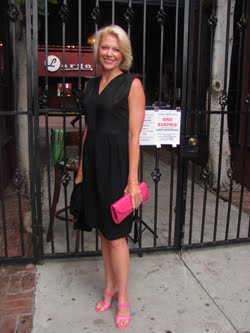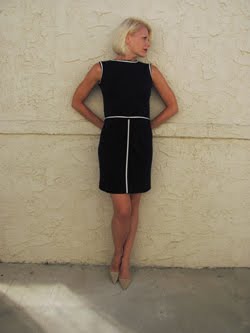Happy holidays! I realize I have been a bit quiet online because of my Pre-Code screening series
The Style of Sin and working on my book
Film Noir Style: The Killer 1940s. The book will be on sale Fall 2020 and I'm very excited about it. Because copy is due by the end of the year, I've been buried in research and feverishly typing away. But I wanted to celebrate this special time of year, so I've gone into the GlamAmor Archive and pulled one of my favorite holiday films
It Happened on Fifth Avenue (1947). I hope you enjoy my look at its classic style.
------
Every year at this time I enjoy looking at style in movies that celebrate the holidays. In the past, this has included
The Thin Man (1934),
The Man Who Came to Dinner (1942), and
White Christmas (1954). Anyone who knows me knows how much I love
film noir, so I have also looked at 1947's
Lady in the Lake. This Christmas I have chosen to cover a holiday film that I've come to know and love in the past few years - 1947's
It Happened on Fifth Avenue.
It Happened on Fifth Avenue is centered on a homeless man named Aloysius T. McKeever (Victor Moore) who takes over a vacant mansion in New York each winter. This Christmas he helps Army veteran Jim Bullock (Don DeFore) and his friends who struggle with their own housing. What makes the movie such fun is that - unbeknownst to anyone - the actual owners of the mansion become part of the ragtag group that now inhabits the house. Some of the charm of the story stems from watching this wealthy family evolve through the experience. For a lesser known picture, these characters are played by an incredible cast and are well known to classic film fans. The movie is led by Moore, who many love in the Fred Astaire-Ginger Rogers musical
Swing Time. The affluent O'Connor family (who pose as anything but) is made up of Charlie Ruggles, Ann Harding, and Gale Storm. And other character actors include the always good Alan Hale, Jr., Grant Mitchell, and Edward Brophy.
This period of time is one of my favorites for film - the reason being that it is right after World War II. I love movies that look at these post-war years and the challenges that servicemen faced when returning to America. William Wyler's
The Best Years of Our Lives probably did this best of all.
It Happened on Fifth Avenue's own storyline starts with Bullock being kicked out of an apartment and then welcomed into McKeever's creative housing solution. Several of Bullock's war buddies soon enter the picture with their families - all with housing challenges of their own.
The post-World War II storyline extends to the costumes as well. For those who don't know, much of 1940s style came as the result of rationing that happened during the war. This is the reason for the functional and rather austere feel of much of the era's clothing. You simply weren't allowed to use a great deal of fabric. The length and circumference of skirts, for instance, were dictated by a government regulation. Though
It Happened on Fifth Avenue was made after rationing had ended, styles had not changed that much. That seismic shift came in February 1947 courtesy of Christian Dior and his "New Look," a collection that featured longer fuller skirts and ushered in the over-the-top femininity of the 1950s.
It Happened on Fifth Avenue premiered in April of that year, but was in production well before that date and its costumes still reflect much of World War II style.
This leads to one of the reasons I wanted to share
It Happened on Fifth Avenue - its costume designer Lorraine MacLean. Clearly she is not as well known as someone like Edith Head, and it's important to remember that the Hollywood studio system was filled with many unsung heroes such as herself. Lorraine is interesting because she started her career as an actress, similar to costume designers Irene and Orry-Kelly. She actually went further as an actress than those two and appeared in movies like
Love Shy (1928) and
Fools for Scandal (1938) with Carole Lombard. After her time on screen, Lorraine moved behind the camera to the makeup department and then onto costume design. She eventually became the studio stylist for Monogram Pictures and Allied Artists.
It Happened on Fifth Avenue was the first production from Allied Artists, the unit that Monogram built for bigger and better productions from the "Poverty Row" studio. You'll see that Lorraine stepped up to the challenge with her costume design. Gale Storm's wardrobe, in particular, is filled with plenty of winter coat inspiration - including fabulous Willard George furs - and classic pieces that would still be stylish today.
It Happened on Fifth Avenue is such a perfect holiday movie. It has lovely messages about family - both those that are blood-related and those people we choose to be in our lives. It also has great inspiration about entrepreneurship and designing your own destiny. Of course it also has plenty of romance and a sweet fairy tale feel to the movie that just makes you feel good. It's become a classic that I must see every holiday and hope you enjoy it, too. Merry Christmas!
Home sweet home -
the O'Connor mansion is the winter residence of Aloysius T. McKeever (Victor Moore)
Jim Bullock (Don DeFore) and McKeever
catch late night prowler Trudy O'Connor (Gale Storm) "stealing" a fur coat and more
Bullock takes back what Trudy has been "stealing"
Trudy overhears why these two strangers are in her home and plays along
as they allow her to stay while she's "down on her luck"
Trudy gets a job at a music store
We see that Trudy is already falling for Bullock
I love this coat of Trudy's with a hood attached that continues the front plaid trim
Bullock's war buddies - and their families - are also allowed join the McKeever household
Trudy wants to see if this nearly strapless gown will turn Bullock's head
I say nearly strapless because the vine-like "strap" is more decorative than functional
Looks like Trudy may have accomplished her mission
Love Trudy's fur-trimmed wrap coat with coordinated fur hat
that she wears when she bumps into her father Michael J. O'Connor (Charles Ruggles)
This leopard coat and hat is another great ensemble from Trudy's wardrobe
A "chance" meeting in Central Park with down-on-his-luck "Mike"
Mike is invited to join all the others and
sees the transformation of the O'Connor mansion
Costume designers put just as much care into robes as they did in coats or gowns -
you can see the careful construction in the shoulders and embroidery in this robe
Trudy pays a visit to her mother Mary O'Connor (Ann Harding)
who is currently separated from her father
Here's a great example of costume establishing a character -
Mary simply exudes wealth and style with her dress, fur coat, hat, and jewelry
Trudy in yet another great coordinated ensemble - double-breasted coat, hat, and gloves -
as she plots to bring Mary into the McKeever household to meet new love Bullock
Mary joins the household - dressed to appear down on her luck as well -
and becomes the cook much to Mike's chagrin
Bullock play referee between Mike and Mary,
not realizing that they're Trudy's separated parents
Christmas comes to the McKeever household
Bullock has fallen for Trudy and vows to prove himself
Trudy's holiday dress would still be perfect today
Bullock gives Trudy a coat for Christmas so she doesn't have to "borrow" any more -
it's more special to her than all of her furs
The last dinner of this extended family
with toasts for the future of the two happy couples and Aloysius McKeever
Merry Christmas!





































































































































































